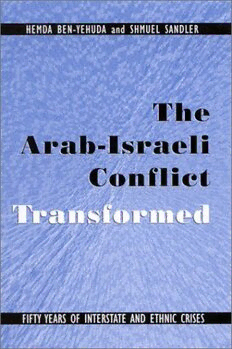
The Arab-Israeli Conflict Transformed: Fifty Years of Interstate and Ethnic Crises PDF
Preview The Arab-Israeli Conflict Transformed: Fifty Years of Interstate and Ethnic Crises
THE ARAB-ISRAELI CONFLICTTRANSFORMED SUNY SERIES IN GLOBAL POLITICS James N.Rosenau editor T A -I HE RAB SRAELI C T ONFLICT RANSFORMED Fifty Years of Interstate and Ethnic Crises HEMDA BEN-YEHUDA and SHMUEL SANDLER STATE UNIVERSITY OF NEW YORK PRESS Published by STATE UNIVERSITY OF NEW YORK PRESS, ALBANY © 2002State University of New York All rights reserved Printed in the United States of America No part of this book may be used or reproduced in any manner whatsoever without written permission. No part of this book may be stored in a retrieval system or transmitted in any form or by any means including electronic, electrostatic, magnetic tape, mechanical, photocopying,recording,or otherwise without the prior permission in writing of the publisher. For information,address State University of New York Press, 90 State Street,Suite 700,Albany,NY 12207 Production,Laurie Searl Marketing,Patrick Durocher Library of Congress Cataloging-in-Publication Data Ben-Yehuda,Hemda,1954, The Arab-Israeli conflict transformed :fifty years of interstate and ethnic crises / Hemda Ben-Yehuda and Shmuel Sandler. p.cm. Includes bibliographical references and index. ISBN 0-7914-5245-X (alk.paper) — ISBN 0-7914-5246-8 (pb :alk.paper) 1.Arab-Israeli conflict.2.Ethnic conflict—Israel.3.Israel—Ethnic relations.4. Jews—Israel—Identity.5.Palestinian Arabs—Ethnic identity. I.Sandler,Shmuel.II.Title. DS119.6 .B465 2002 956—dc21 2002017695 10 9 8 7 6 5 4 3 2 1 In loving memory of my parents Dora and Ehud Ben-Yehuda, and their devotion to the realization of Eliezer Ben-Yehuda’s dream: The national revival of the Jewish people, in their homeland,speaking their native tongue. Hemda Ben-Yehuda And to Sara Lainer, a special lady who also believed in the Jewish people and their language. Shmuel Sandler C ONTENTS List ofTables viii Preface ix Acronyms xi 1 THEORETICALAPPROACHESTO CONFLICTAND ORDER IN INTERNATIONAL POLITICS 1 2 CONTEXT,CRISIS MAGNITUDE,AND CHANGE 27 3 PROCESS,OUTCOMES,OVERALL CRISIS MAGNITUDE, AND CHANGE 59 4 CRISIS MAGNITUDEAND CONFLICTTRANSFORMATION 85 5 ETHNIC CRISES INA COMPOUND CONFLICT 117 6 NEW DIMENSIONS INTHEARAB-ISRAELI CONFLICT: FROMTHE INTIFADA 1987TO INTIFADA 2000 141 7 UNDERSTANDINGTRANSFORMATION INTHE ARAB-ISRAELI CONFLICT 167 Glossary of Crises in the Arab-Israeli Conflict 181 Notes 197 Bibliography 233 Index 281 L T IST OF ABLES Table 1.1 The CMI—Realms,Indicators,Values and Postulates 15 Table 2.1 Context Attributes of Crises in the Arab-Israeli Conflict 31 Table 3.1 Process and Outcome Attributes of Crises in the Arab-Israeli Conflict 60 Table 4.1 Gravity of Arab-Israeli Crises,1947–2000 87 Table 4.2 Actors in Arab-Israeli Crises,1947–2000 89 Table 4.3 Superpower Involvement in Arab-Israeli Crises,1947–2000 90 Table 4.4 Crisis Management Technique in Arab-Israeli Crises,1947–2000 91 Table 4.5 Violence in Arab-Israeli Crises,1947–2000 92 Table 4.6 Outcomes in Arab-Israeli Crises,1947–2000 93 Table 4.7 CMI Scores of Crises in the Arab-Israeli Conflict 1947–2000 96 Table 4.8 The 1948 War:Opposing Field Forces 100 Table 4.9 Conditions for Change in the Arab-Israeli Conflict 102 Table 4.10 Israel and Egypt:The Distribution of Military Power at the End of 1955 104 Table 4.11 The 1956 War:Distribution of Israeli and Egyptian Forces along the Sinai Front 105 Table 4.12 The June 1967 War:The Arab-Israeli Military Balance 107 Table 4.13 The October 1973 War:The Arab-Israeli Military Balance 111 Table 5.1 Ethnic-State Crises in the Arab-Israeli Conflict:1947–1973 127 Table 5.2 Interstate Crises in the Arab-Israeli Conflict:1947–1973 128 Table 5.3 Ethnic-State Crises in the Arab-Israeli Conflict:1974–2000 135 Table 5.4 Interstate Crises in the Arab-Israeli Conflict:1974–2000 136 viii P REFACE As we write this in the winter of 2001, the Middle East is again suffering through a dangerous state of continued strife.It is our contention,however,that despite serious and sustained violent outbursts,the overall nature of the Arab- Israeli relationship has been changing over the last two decades.This study uses a theoretical framework and empirical evidence to support the perhaps surpris- ing argument that the Arab-Israeli conflict has been winding down and chang- ing from a predominantly interstate dispute into a Palestinian-Israeli ethnic- state struggle. Our theoretical analysis considers and then goes beyond the current debate within the International Relations (IR) field over the relative merits of the realist/neorealist versus the neoliberal-institutional approaches in explaining international order.In addition,we integrate the ethonational theo- retical literature into our frame of analysis. It is very difficult for two Israelis to write an objective book on the Middle East.Hence,we searched for what we believe is an unbiased source—the world- wide data-set drawn from Michael Brecher and Jonathan Wilkenfeld’s International Crisis Behavior (ICB)project. Our contribution in identifying and explaining change in the Arab-Israeli conflict is the index of crisis magni- tude (CMI),which measures the extent of change in crisis attributes.The CMI’s three realms (context,process,and outcome) and its six indicators (gravity of threat;number of actors;superpower role;crisis management techniques;scope of violence;and termination) serve as our basis for illuminating change in cri- sis evolution and conflict dynamics,for a period of over fifty years. Another theoretical contribution is the set of conditions that we suggest affect moderation in a protracted conflict.These conditions induce change from an anarchical system to one in which a security regime promotes order.We test these conditions along critical turning points in the evolution of the Arab- Israeli conflict.Subsequently,we analyze changes in the ethnic-state domain,the latter being the primary source for the continuing nontermination of the con- flict. The book is thematically divided into seven chapters.Chapter 1 presents the theoretical framework for all further analysis. Chapters 2–4 focus on the interstate dimension, while chapters 5 and 6 analyze the ethnic-state and ix
